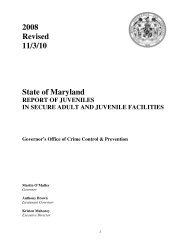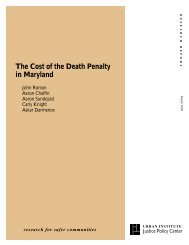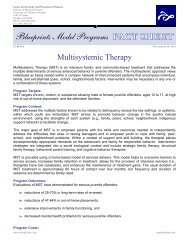Targeted Outreach - Governor's Office of Crime Control & Prevention ...
Targeted Outreach - Governor's Office of Crime Control & Prevention ...
Targeted Outreach - Governor's Office of Crime Control & Prevention ...
You also want an ePaper? Increase the reach of your titles
YUMPU automatically turns print PDFs into web optimized ePapers that Google loves.
34 <strong>Targeted</strong> <strong>Outreach</strong><br />
Clubs had varying experiences trying to engage<br />
schools in collaboration and referrals. At one Club<br />
where the relationship between the schools and the<br />
Club was solid, the relationships became even<br />
stronger because the Club employs teachers as afterschool<br />
instructors, and former Club staff are teachers<br />
at nearby schools. In another city, a middle school<br />
principal expressed her positive response to the Club<br />
staff’s willingness to spend time at the school over<br />
the lunch hour and hang out with the youth in the<br />
lunch room and school yard. She felt that by doing<br />
so, they helped the youth and the teachers to be<br />
more aware <strong>of</strong> what the Clubs could <strong>of</strong>fer and how<br />
they could help the teachers. Not surprisingly, at<br />
Clubs where the buy-in <strong>of</strong> the local schools is greatest,<br />
the Club staff’s ability to follow up on youth’s<br />
progress at school and identify educational areas <strong>of</strong><br />
need are also greatest.<br />
Responsiveness to the Clubs from any <strong>of</strong> these outside<br />
agencies took time to build. One Club indicated<br />
it spent a year reaching out to multiple agencies with<br />
little response. At the start <strong>of</strong> their second year <strong>of</strong><br />
GPTTO, the Club focused on fewer agencies and was<br />
subsequently able to build a solid relationship with<br />
probation that is leading to new referrals.<br />
Relationships between partner agencies and the<br />
Clubs not only take time to establish, they also<br />
require ongoing maintenance. Staff turnover at the<br />
partner agencies is a key obstacle to maintaining<br />
relationships. Partner agencies felt keeping staff at<br />
their agency familiar with the program would help<br />
improve the Clubs’ effectiveness. Partner agency<br />
staff felt that they would benefit from at least a<br />
yearly presentation so that the word about GPTTO<br />
and GITTO would be transmitted effectively to new<br />
staff. In order to maximize the potential for the relationship<br />
to produce referrals and partnerships,<br />
training sessions and contact with organizations<br />
should occur more frequently than yearly.<br />
The establishment <strong>of</strong> a network <strong>of</strong> partnerships with<br />
other agencies is a prerequisite to success in recruitment<br />
and outreach, particularly with regard to referrals<br />
both into and out <strong>of</strong> the Club. The next section<br />
describes the recruitment process.<br />
Recruitment<br />
The Clubs’ existing recruitment efforts (i.e., word <strong>of</strong><br />
mouth, membership drives) would not have been<br />
sufficient to reach the youth intended for GPTTO<br />
and GITTO. Youth most at risk <strong>of</strong> gang involvement<br />
or hard-core gang members are not likely to walk<br />
through the doors <strong>of</strong> the Club on their own (Boys &<br />
Girls Clubs <strong>of</strong> America, 1993). Thus, the Clubs<br />
involved in the initiative had to make special efforts<br />
to identify appropriate youth and entice them into<br />
the Club.<br />
To identify and recruit youth at risk <strong>of</strong> gang involvement<br />
and those who are already gang members,<br />
BGCA recommends two general approaches. The<br />
first is direct outreach, which typically consists <strong>of</strong><br />
Club staff getting to know youth outside the Club<br />
and encouraging them to join. The second is recruiting<br />
youth via referrals, which requires developing<br />
strong ties with community agencies and organizations<br />
that can direct youth to Clubs and their staff.<br />
Clubs utilizing GPTTO and GITTO used both methods<br />
<strong>of</strong> recruitment.<br />
Direct <strong>Outreach</strong><br />
As noted in Chapter II, 35 percent <strong>of</strong> the prevention<br />
and 29 percent <strong>of</strong> the intervention target youth were<br />
recruited through direct outreach. The proportions<br />
ranged from 0 percent to 83 percent among prevention<br />
Clubs and 0 percent to 60 percent among intervention<br />
Clubs. All Clubs, however, attempted to<br />
recruit through direct outreach, with varying success<br />
for different methods.<br />
Direct outreach at schools appeared to be one <strong>of</strong> the<br />
more effective methods. Five Clubs noted that going<br />
to schools, hanging out there and passing out flyers—with<br />
the approval <strong>of</strong> school administrators—<br />
helped them identify youth and attract their interest.<br />
Even though these efforts took place on school<br />
grounds, we can consider them to be direct outreach<br />
because they did not involve teacher referrals.<br />
Six Clubs noted the importance <strong>of</strong> having an outreach<br />
coordinator who visits schools, goes to parks<br />
and other youth hangouts and visits youth homes.<br />
Several Clubs hired members <strong>of</strong> the local community<br />
with whom families and youth felt comfortable.

















